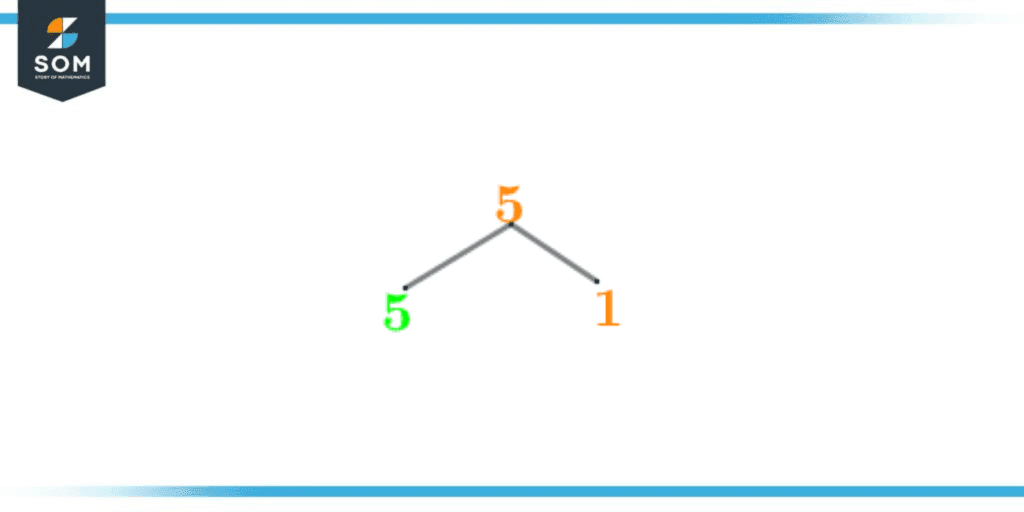JUMP TO TOPIC
Factors of 5: Prime Factorization, Methods, Tree, and Examples
The number 5 is an odd number as well as a prime number. This indicates that it has only two factors. All the natural numbers that divide 5 into equal parts are termed as its factors. Factors can be assumed as the numbers that leave nothing as the remainder.
Figure 1 – All possible Factors of 5
What Are the Factors of 5?
The factors of 5 are 1 and 5; it is a prime number so it has only two factors.Prime numbers are the numbers that are only divisible by 1 and themselves. The number 5 is also a prime number as it is not a multiple of any other number except 1 and 5. Let’s discuss how to find the factors, prime factors, and factor pairs of number 5.How To Calculate the Factors of 5?
You can calculate the factors of number 5 by using a simple technique called the division method. The technique involves dividing a number from one to that particular number. In this case, the number under consideration is 5. Therefore, we will divide 5 by the list of numbers containing natural numbers from 1 to 5.Once the division has been performed separate the numbers that divide fully with zero as a remainder. Let’s see how it works.Firstly, make a list of natural numbers from 1 to 5. One important thing to notice here is that a number cannot have a factor greater than itself. So, the biggest factor of 5 can be 5.Start dividing 5 by each number given in the list and analyze the remainder of the division.For 1:\[ \dfrac{5}{1} = 5 \]Since, in this case, the remainder of the division is zero. Therefore, 1 is the factor of 5. It is to be noticed that 1 is divisible by every natural number hence it is the factor of every natural number. Due to this particular property, it is also called a universal factor. But 1 is not a prime number. The number 1 is also the smallest natural number.Now consider 2 as the next number in the list. Divide it by 5 but this time remainder will not be zero as 2 is a prime number and it can never be divided by an odd number. Dividing 5 by 2 yields a decimal. Also, a factor can never be in the form of a decimal or fraction.\[ \dfrac{5}{2} = 2.5 \]Now check for the next number which is 3. 3 is also not completely divisible by 5. For a number to be a factor it must be evenly divided into equal parts. Therefore 3 is also not the factor of 5 as the remainder is not equivalent to zero.The same goes for the number 4 as when 5 is divided by 4 the remainder is 1 hence it is not the factor of 5.Finally coming to number 5, the last number in the list, as discussed earlier the number itself is its biggest factor. When 5 is divided by 5 the remainder is zero. Hence 5 is the factor of 5.\[ \dfrac{5}{5} = 1 \]Important Properties of Factors of 5
Following are some tips that must be considered while finding the factors of any number.- Prime numbers have only two factors whereas composite numbers have more than two factors.
- The factors of a number can neither be in decimal form nor a fraction.
- The biggest factor of a number is the number itself.
- The factors of the number can be negative as well provided that their product is always equal to the given number.
- The total number of factors of a number is finite.
- The number 1 and the number itself are always the factors of that particular number.
Total Number of Factors of 5
The total number of factors of any given number can be easily found using a simple method stated below.To find the total number of factors of any given number, write its factorization. Add 1 to each exponent of the given factors. Now multiply the resulting exponents. The product is equivalent to the total number of factors of that particular number.In the case of number 5, the factorization is 1 x 5. The exponent of each factor is 1. Adding 1 to each and multiplying them gives 4 as a result. Therefore number 5 has 4 factors, 2 of them are positive and 2 are negative.The positive factors of 5 are given as:Positive factors = 1, 5
The negative factors of 5 are given as:Negative factors = -1, -5
The list of factors of 5 is given as:List of factors = 1, -1, 5, -5
Factors of 5 by Prime Factorization
Prime factorization is a technique of expressing the given number as the product of its prime factors. Prime factors of any number are the factors that are only divisible by 1 and themselves.The prime factorization of 5 is simplest as it is a prime number itself. The prime factorization of number 5 by upside division is shown below in figure 1:
Figure 2 – Prime Factorization of 5
1 x 5 = 5
Factor Tree of 5
A factor tree is one of the ways to represent the prime factors of a given number. It is a pictorial description indicating the flow of division. A factor tree splits out into the branches containing the quotient and divisor of the division.One interesting fact about the factor tree is that it always ends at the prime factors thus revealing the prime factors of the given number in an understandable manner.The factor tree of number 5 is given below in figure 2:
Figure 3 – Factor Tree of 5
Factors of 5 in Pairs
The factors of the given number when expressed in pairs and multiplied together to produce that number are called the factors pairs of the given number. Since 5 is a prime number with only two factors. Hence 5 has only 1-factor pair.The factor pair of number 5 is (1, 5).The factor pair of number 5 can be negative as well. The negative factor pair is nothing but the positive factor pair with opposite signs.The negative factor pair of number 5 is (-1, -5).Factors of 5 Solved Examples
Let us solve some examples involving the factors of 5.Example 1
Determine the average of the factors of 5.Solution
To determine the average of the factors of 5, first, let’s list down all the possible factors of 5. The factors of 5 are given below:Factors of 5 = 1, 5
For calculating the average, let’s first take a look at the formula for determining the average. The formula for calculating average is given below: \[ \text{Average} = \frac{\text{Sum of factors}}{\text{Total number of factors}} \]\[ \text{Average} = \frac{1+5}{2} \]\[ \text{Average} = \frac{6}{2} \]Average = 3
Hence, the average of the factors of 5 is 3.Example 2
Determine the sum of the even and the odd factors of 5.Solution
To determine the sum of the even and the odd factors of 5, let’s first list down all the factors of 5. The factors of 5 are:Factors of 5 = 1, 5
Now, let’s take a look at the odd factors of 5. The odd factors of 5 are given below:Odd factors of 5 = 1, 5
Now, calculating the sum of these odd factors of 5:Sum of odd factors = 1 + 5
Sum of odd factors = 6
Hence, the sum of odd factors of 5 is 6.Now, let’s take a look at the even factors of 5. Since there are no even factors of 5 hence their sum is zero.Sum of even factors of 5 = 0
Example 3
Calculate the product of the factors of 5 and determine if it’s an odd number or an even number. Also, determine if this number is a multiple of 2.Solution
To determine the product of the factors of 5, let’s first list down these numbers:Factors of 5 = 1, 5
Calculating the product of these factors = 1 x 5
Product of factors of 5 = 5
Hence, the product of the factors of 5 is an odd number since it’s the number 5. As it is an odd number, hence, this number 5 is not a multiple of 2. All images / mathematical drawings are created with GeoGebra.